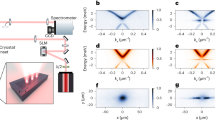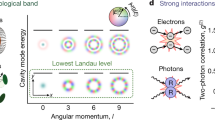Abstract
Guiding many-body systems to desired states is a central challenge of modern quantum science, with applications from quantum computation1,2 to many-body physics3 and quantum-enhanced metrology4. Approaches to solving this problem include step-by-step assembly5,6, reservoir engineering to irreversibly pump towards a target state7,8 and adiabatic evolution from a known initial state9,10. Here we construct low-entropy quantum fluids of light in a Bose–Hubbard circuit by combining particle-by-particle assembly and adiabatic preparation. We inject individual photons into a disordered lattice for which the eigenstates are known and localized, then adiabatically remove this disorder, enabling quantum fluctuations to melt the photons into a fluid. Using our platform11, we first benchmark this lattice melting technique by building and characterizing arbitrary single-particle-in-a-box states, then assemble multiparticle strongly correlated fluids. Intersite entanglement measurements performed through single-site tomography indicate that the particles in the fluid delocalize, whereas two-body density correlation measurements demonstrate that they also avoid one another, revealing Friedel oscillations characteristic of a Tonks–Girardeau gas12,13. This work opens new possibilities for the preparation of topological and otherwise exotic phases of synthetic matter3,14,15.
This is a preview of subscription content, access via your institution
Access options
Access Nature and 54 other Nature Portfolio journals
Get Nature+, our best-value online-access subscription
$29.99 / 30 days
cancel any time
Subscribe to this journal
Receive 51 print issues and online access
$199.00 per year
only $3.90 per issue
Buy this article
- Purchase on Springer Link
- Instant access to full article PDF
Prices may be subject to local taxes which are calculated during checkout




Similar content being viewed by others
Data availability
The experimental data presented in this manuscript are available from the corresponding author upon request, due to the proprietary file formats used in the data collection process.
Code availability
The source code for simulations throughout are available from the corresponding author upon request.
References
Laflamme, R., Miquel, C., Paz, J. P. & Zurek, W. H. Perfect quantum error correcting code. Phys. Rev. Lett. 77, 198–201 (1996).
Devitt, S. J., Munro, W. J. & Nemoto, K. Quantum error correction for beginners. Rep. Prog. Phys. 76, 076001 (2013).
Carusotto, I. et al. Photonic materials in circuit quantum electrodynamics. Nat. Phys. 16, 268–279 (2020).
Pezze, L., Smerzi, A., Oberthaler, M. K., Schmied, R. & Treutlein, P. Quantum metrology with nonclassical states of atomic ensembles. Rev. Mod. Phys. 90, 035005 (2018).
Grusdt, F., Letscher, F., Hafezi, M. & Fleischhauer, M. Topological growing of Laughlin states in synthetic gauge fields. Phys. Rev. Lett. 113, 155301 (2014).
Dallaire-Demers, P.-L., Romero, J., Veis, L., Sim, S. & Aspuru-Guzik, A. Low-depth circuit ansatz for preparing correlated fermionic states on a quantum computer. Quantum Sci. Technol. 4, 045005 (2019).
Kapit, E., Hafezi, M. & Simon, S. H. Induced self-stabilization in fractional quantum Hall states of light. Phys. Rev. X 4, 031039 (2014).
Lebreuilly, J. et al. Stabilizing strongly correlated photon fluids with non-Markovian reservoirs. Phys. Rev. A 96, 033828 (2017).
Albash, T. & Lidar, D. A. Adiabatic quantum computation. Rev. Mod. Phys. 90, 015002 (2018).
Zurek, W. H., Dorner, U. & Zoller, P. Dynamics of a quantum phase transition. Phys. Rev. Lett. 95, 105701 (2005).
Ma, R. et al. A dissipatively stabilized Mott insulator of photons. Nature 566, 51–57 (2019).
Tonks, L. The complete equation of state of one, two and three-dimensional gases of hard elastic spheres. Phys. Rev. 50, 955–963 (1936).
Girardeau, M. Relationship between systems of impenetrable bosons and fermions in one dimension. J. Math. Phys. 1, 516–523 (1960).
Goldman, N., Budich, J. C. & Zoller, P. Topological quantum matter with ultracold gases in optical lattices. Nat. Phys. 12, 639–645 (2016).
Ozawa, T. et al. Topological photonics. Rev. Mod. Phys. 91, 015006 (2019).
Blatt, R. & Roos, C. F. Quantum simulations with trapped ions. Nat. Phys. 8, 277–284 (2012).
Bloch, I., Dalibard, J. & Nascimbene, S. Quantum simulations with ultracold quantum gases. Nat. Phys. 8, 267–276 (2012).
Clark, L. W., Schine, N., Baum, C., Jia, N. & Simon, J. Observation of Laughlin states made of light. Nature 582, 41–45 (2020).
Chen, Q., Stajic, J., Tan, S. & Levin, K. BCS–BEC crossover: from high temperature superconductors to ultracold superfluids. Phys. Rep. 412, 1–88 (2005).
Greiner, M., Mandel, O., Esslinger, T., Hänsch, T. W. & Bloch, I. Quantum phase transition from a superfluid to a Mott insulator in a gas of ultracold atoms. Nature 415, 39–44 (2002).
Cooper, N., Dalibard, J. & Spielman, I. Topological bands for ultracold atoms. Rev. Mod. Phys. 91, 015005 (2019).
Bakr, W. S., Gillen, J. I., Peng, A., Fölling, S. & Greiner, M. A quantum gas microscope for detecting single atoms in a Hubbard-regime optical lattice. Nature 462, 74–77 (2009).
Trotzky, S. et al. Time-resolved observation and control of superexchange interactions with ultracold atoms in optical lattices. Science 319, 295–299 (2008).
Islam, R. et al. Measuring entanglement entropy in a quantum many-body system. Nature 528, 77–83 (2015).
Karamlou, A. H. et al. Quantum transport and localization in 1d and 2d tight-binding lattices. npj Quantum Inform. 8, 35 (2022).
Zhang, J. et al. Observation of a discrete time crystal. Nature 543, 217–220 (2017).
Choi, S. et al. Observation of discrete time-crystalline order in a disordered dipolar many-body system. Nature 543, 221–225 (2017).
Choi, J.-Y. et al. Exploring the many-body localization transition in two dimensions. Science 352, 1547–1552 (2016).
Roushan, P. et al. Spectroscopic signatures of localization with interacting photons in superconducting qubits. Science 358, 1175–1179 (2017).
Bluvstein, D. et al. Controlling quantum many-body dynamics in driven Rydberg atom arrays. Science 371, 1355–1359 (2021).
Brown, P. T. et al. Bad metallic transport in a cold atom Fermi–Hubbard system. Science 363, 379–382 (2019).
McIver, J. W. et al. Light-induced anomalous Hall effect in graphene. Nat. Phys. 16, 38–41 (2020).
Choi, S., Bao, Y., Qi, X.-L. & Altman, E. Quantum error correction in scrambling dynamics and measurement-induced phase transition. Phys. Rev. Lett. 125, 030505 (2020).
Eisert, J., Friesdorf, M. & Gogolin, C. Quantum many-body systems out of equilibrium. Nat. Phys. 11, 124–130 (2015).
Simon, J. et al. Quantum simulation of antiferromagnetic spin chains in an optical lattice. Nature 472, 307–312 (2011).
Mazurenko, A. et al. A cold-atom Fermi–Hubbard antiferromagnet. Nature 545, 462–466 (2017).
Ma, R., Owens, C., Houck, A., Schuster, D. I. & Simon, J. Autonomous stabilizer for incompressible photon fluids and solids. Phys. Rev. A 95, 043811 (2017).
Bak, P. Commensurate phases, incommensurate phases and the devil’s staircase. Rep. Prog. Phys. 45, 587 (1982).
Umucalílar, R., Simon, J. & Carusotto, I. Autonomous stabilization of photonic Laughlin states through angular momentum potentials. Phys. Rev. A 104, 023704 (2021).
Gemelke, N., Zhang, X., Hung, C.-L. & Chin, C. In situ observation of incompressible Mott-insulating domains in ultracold atomic gases. Nature 460, 995–998 (2009).
Zhou, Y., Kanoda, K. & Ng, T.-K. Quantum spin liquid states. Rev. Mod. Phys. 89, 025003 (2017).
Kinoshita, T., Wenger, T. & Weiss, D. S. Observation of a one-dimensional Tonks–Girardeau gas. Science 305, 1125–1128 (2004).
Paredes, B. et al. Tonks–Girardeau gas of ultracold atoms in an optical lattice. Nature 429, 277–281 (2004).
Cazalilla, M. A., Citro, R., Giamarchi, T., Orignac, E. & Rigol, M. One dimensional bosons: from condensed matter systems to ultracold gases. Rev. Mod. Phys. 83, 1405–1466 (2011).
Meyer, D. A. & Wallach, N. R. Global entanglement in multiparticle systems. J. Math. Phys. 43, 4273 (2002).
Chandran, A., Erez, A., Gubser, S. S. & Sondhi, S. L. Kibble–Zurek problem: universality and the scaling limit. Phys. Rev. B 86, 064304 (2012).
Owens, J. C. et al. Chiral cavity quantum electrodynamics. Nat. Phys. 18, 1048–1052 (2022).
Swingle, B., Bentsen, G., Schleier-Smith, M. & Hayden, P. Measuring the scrambling of quantum information. Phys. Rev. A 94, 040302 (2016).
Grusdt, F., Yao, N. Y., Abanin, D., Fleischhauer, M. & Demler, E. Interferometric measurements of many-body topological invariants using mobile impurities. Nat. Commun. 7, 11994 (2016).
Koch, J. et al. Charge-insensitive qubit design derived from the Cooper pair box. Phys. Rev. A 76, 042319 (2007).
Acknowledgements
This work was supported by ARO MURI grant W911NF-15-1-0397, AFOSR MURI grant FA9550-19-1-0399 and by NSF Eager grant 1926604. Support was also provided by the Chicago MRSEC, which is funded by NSF through grant DMR-1420709. G.R. and M.G.P. acknowledge support from the NSF GRFP. A.V. acknowledges support from the MRSEC-funded Kadanoff–Rice Postdoctoral Research Fellowship. Devices were fabricated in the Pritzker Nanofabrication Facility at the University of Chicago, which receives support from Soft and Hybrid Nanotechnology Experimental (SHyNE) Resource (NSF ECCS-1542205), a node of the National Science Foundation’s National Nanotechnology Coordinated Infrastructure.
Author information
Authors and Affiliations
Contributions
The experiments were designed by B.S., A.V., G.R., J.S. and D.I.S. The apparatus was built by B.S., A.V. and G.R. The collection of data was handled by B.S., A.V. and G.R. All authors analysed the data and contributed to the manuscript.
Corresponding author
Ethics declarations
Competing interests
The authors declare no competing interests.
Peer review
Peer review information
Nature thanks the anonymous reviewers for their contribution to the peer review of this work.
Additional information
Publisher’s note Springer Nature remains neutral with regard to jurisdictional claims in published maps and institutional affiliations.
Extended data figures and tables
Extended Data Fig. 1 Adiabaticity Curves for All \(\bar{n}\) Fillings.
Adiabaticity is given by the average number of photons that return to the originally excited sites as a function of ramp length. Here, we measure adiabaticity curves for the highest energy eigenstate for all \(\bar{n}\) fillings, revealing the minimum ramp length needed to be adiabatic when preparing these many-body states. As particle number increases, we start to suffer more from loss and no longer fully recover the initial starting population.
Extended Data Fig. 2 Profiles for \(\bar{n}\) Fillings.
Density profiles for the highest energy eigenstates, corresponding to fluid ground states, for filling \(\bar{n}\)=\(\frac{1}{7}\) through \(\frac{6}{7}\). For 5 and 6 particles, our results suffer from particle loss.
Extended Data Fig. 3 Entanglement for \(\bar{n}\) Fillings.
Measure of entanglement vs disorder, for filling \(\bar{n}\)=\(\frac{1}{7}\) through \(\frac{6}{7}\). Error bars reflect S.E.M.; here they are smaller than markers.
Supplementary information
Supplementary Information
Supplementary Sections A–J, Table 1, Figs. 1–7 and references.
Rights and permissions
Springer Nature or its licensor (e.g. a society or other partner) holds exclusive rights to this article under a publishing agreement with the author(s) or other rightsholder(s); author self-archiving of the accepted manuscript version of this article is solely governed by the terms of such publishing agreement and applicable law.
About this article
Cite this article
Saxberg, B., Vrajitoarea, A., Roberts, G. et al. Disorder-assisted assembly of strongly correlated fluids of light. Nature 612, 435–441 (2022). https://doi.org/10.1038/s41586-022-05357-x
Received:
Accepted:
Published:
Issue Date:
DOI: https://doi.org/10.1038/s41586-022-05357-x
This article is cited by
-
Quantum behavior of the Duffing oscillator at the dissipative phase transition
Nature Communications (2023)
Comments
By submitting a comment you agree to abide by our Terms and Community Guidelines. If you find something abusive or that does not comply with our terms or guidelines please flag it as inappropriate.



